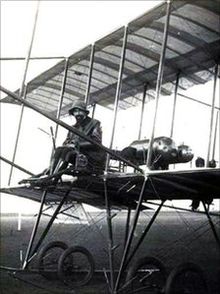Giulio Gavotti: Difference between revisions
Citation bot (talk | contribs) Alter: url. URLs might have been anonymized. | Use this bot. Report bugs. | Suggested by BrownHairedGirl | Linked from User:BrownHairedGirl/Articles_with_bare_links | #UCB_webform_linked 1027/2199 |
m Moving from Category:Aviation pioneers to Category:Italian aviation pioneers using Cat-a-lot |
||
| (17 intermediate revisions by 10 users not shown) | |||
| Line 1: | Line 1: | ||
{{Short description|Italian pilot (1882–1939)}} |
|||
[[File:Giulio Gavotti.jpg|thumb|Giulio Gavotti on a [[Farman]] biplane |
[[File:Giulio Gavotti.jpg|thumb|Giulio Gavotti on a [[Farman]] biplane in Rome (1910)]] |
||
'''Giulio Gavotti''' (17 October 1882 in [[Genoa]] – 6 October 1939) was an [[Italian Army|Italian]] [[lieutenant]] and pilot |
'''Giulio Gavotti''' (17 October 1882 in [[Genoa]] – 6 October 1939) was an [[Italian Army|Italian]] [[lieutenant]] and pilot who fought in the [[Italo-Turkish War]]. |
||
==Aerial bombardment== |
==Aerial bombardment== |
||
On 1 November 1911, he flew his early model [[Etrich Taube]] monoplane against [[Military of the Ottoman Empire|Ottoman military]] in [[Libya]].{{r|Flight100_59}}{{r|i}}{{r|c}} He took four grenades ("''Cipelli''"{{r|c}}) in a leather pouch, each of a size of grapefruit and weighing about four pounds.{{r|i}} Flying at an altitude of 600 feet, Gavotti screwed in the detonators and tossed each munition over the side{{r|Flight100_59}} |
On 1 November 1911, he flew his early model [[Etrich Taube]] monoplane against [[Military of the Ottoman Empire|Ottoman military]] in [[Libya]].{{r|Flight100_59}}{{r|i}}{{r|c}} He took four grenades ("''Cipelli''"{{r|c}}) in a leather pouch, each of a size of grapefruit and weighing about four pounds.{{r|i}} Flying at an altitude of 600 feet, Gavotti screwed in the detonators and tossed each munition over the side{{r|Flight100_59}}—three onto the [[Tagiura]] ([[Jagiura]]) [[oasis]] and one more onto [[military camp]] at [[Ain Zara]].{{r|i}} This event is the first recorded [[airstrike]] launched from an airplane.<ref>{{Cite book |last=Lindqvist |first=Sven |url=https://www.worldcat.org/oclc/44794868 |title=A history of bombing |date=2001 |publisher=New Press |isbn=1-56584-625-7 |location=New York |oclc=44794868}}</ref>{{r|c}} |
||
| ⚫ | After this and further missions, the [[Ottoman Empire]] issued a protest. The dropping of bombs from [[balloon]]s had been outlawed by the [[Hague Conventions of 1899 and 1907|Hague Convention of 1899]], but Italy argued that this ban did not extend to heavier-than-air craft.<ref name="Flight100_59" /> |
||
| ⚫ | |||
| ⚫ | |||
| ⚫ | After this and further missions, the [[Ottoman Empire]] issued a protest. The dropping of bombs from [[balloon]]s had been outlawed by the [[Hague Conventions of 1899 and 1907|Hague Convention of 1899]], but Italy argued that this ban did not extend to heavier-than-air craft.<ref name="Flight100_59"/> |
||
==Night mission== |
==Night mission== |
||
| Line 35: | Line 36: | ||
[[Category:Italian Air Force personnel]] |
[[Category:Italian Air Force personnel]] |
||
[[Category:Italian military personnel of the Italo-Turkish War]] |
[[Category:Italian military personnel of the Italo-Turkish War]] |
||
[[Category: |
[[Category:Italian aviation pioneers]] |
||
{{Italy-mil-bio-stub}} |
{{Italy-mil-bio-stub}} |
||
Latest revision as of 04:25, 12 April 2024

Giulio Gavotti (17 October 1882 in Genoa – 6 October 1939) was an Italian lieutenant and pilot who fought in the Italo-Turkish War.
Aerial bombardment[edit]
On 1 November 1911, he flew his early model Etrich Taube monoplane against Ottoman military in Libya.[1][2][3] He took four grenades ("Cipelli"[3]) in a leather pouch, each of a size of grapefruit and weighing about four pounds.[2] Flying at an altitude of 600 feet, Gavotti screwed in the detonators and tossed each munition over the side[1]—three onto the Tagiura (Jagiura) oasis and one more onto military camp at Ain Zara.[2] This event is the first recorded airstrike launched from an airplane.[4][3]
After this and further missions, the Ottoman Empire issued a protest. The dropping of bombs from balloons had been outlawed by the Hague Convention of 1899, but Italy argued that this ban did not extend to heavier-than-air craft.[1]
The oldest known preserved Etrich Taube, in Vienna, Austria, is possibly a near-twin to the aircraft Gavotti flew in 1911, as both are said to have been powered with inline four-cylinder liquid-cooled powerplants.
Night mission[edit]
Gavotti performed the historically first night mission of a heavier-than-air aircraft. It took place as part of the same campaign in Libya on 4 March 1912.[5]
See also[edit]
Notes[edit]
- ^ a b c d Grant, R.G. (2004). Flight - 100 Years of Aviation. Dorling-Kindersley Limited. p. 59. ISBN 1-4053-0575-4.
- ^ a b c d The influence of air power upon history by Walter J. Boyne, p.38
- ^ a b c d Chant, Christopher (2002). Austro-Hungarian aces of World War 1. Oxford: Osprey. pp. 38–39. ISBN 1-84176-376-4.
- ^ Lindqvist, Sven (2001). A history of bombing. New York: New Press. ISBN 1-56584-625-7. OCLC 44794868.
- ^ "Libya 1911: How an Italian pilot began the air war era". BBC News Website. May 10, 2011. Retrieved May 10, 2011.
